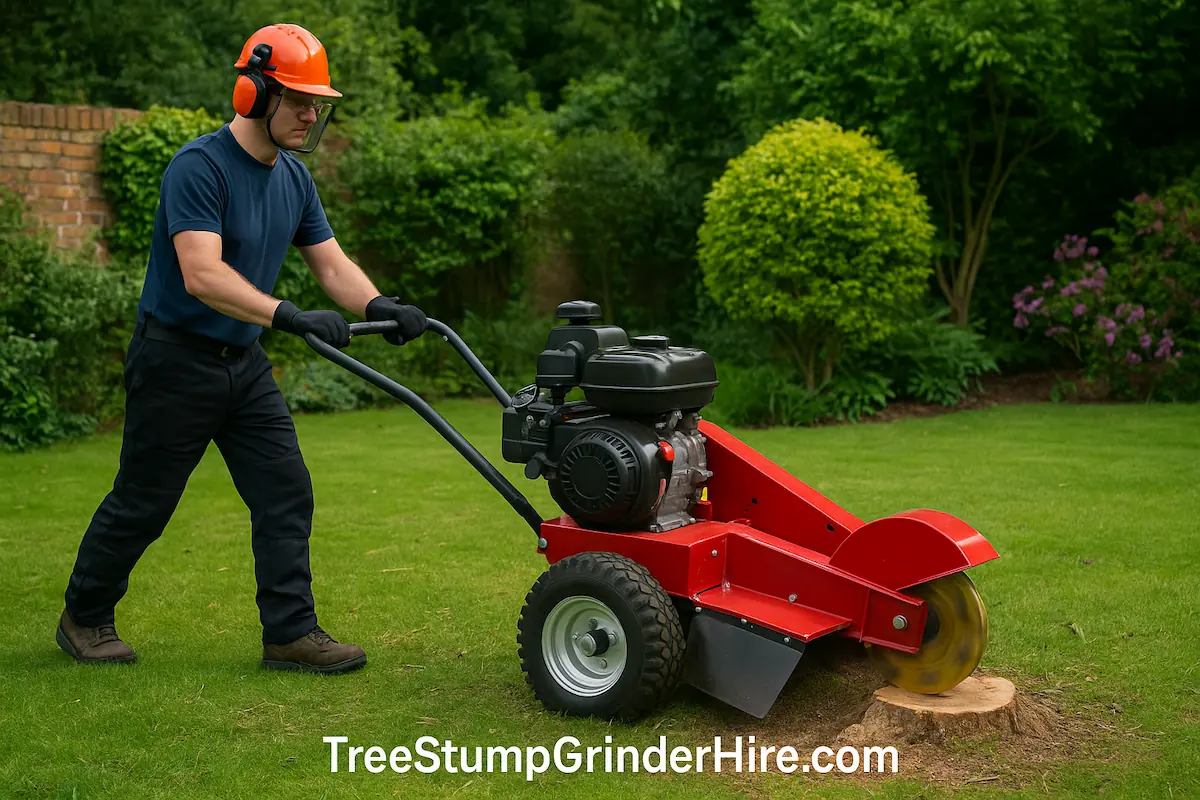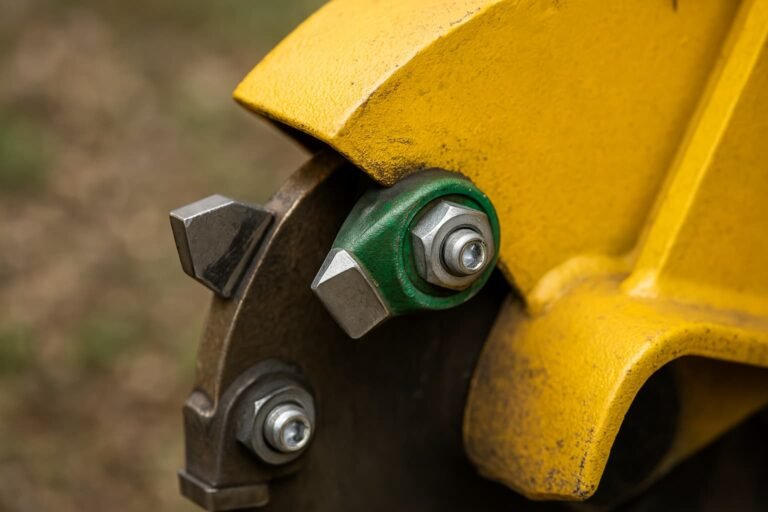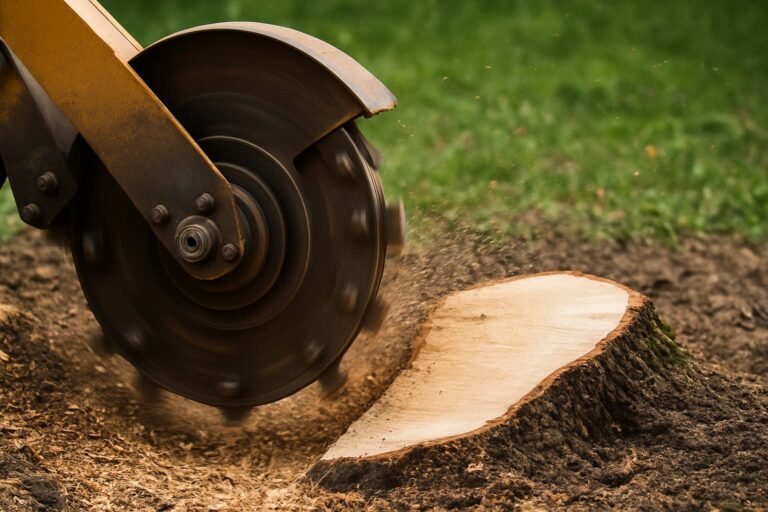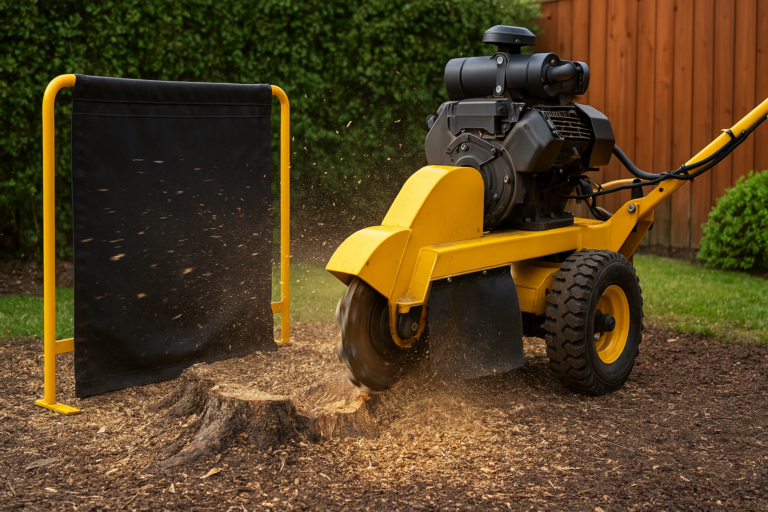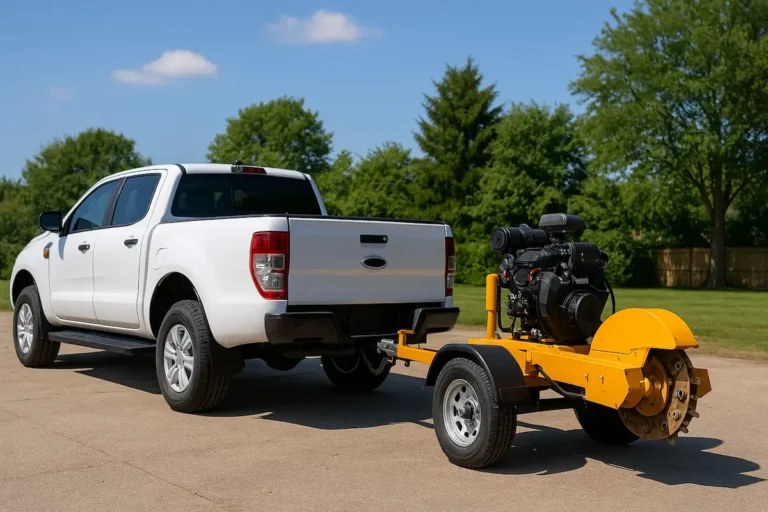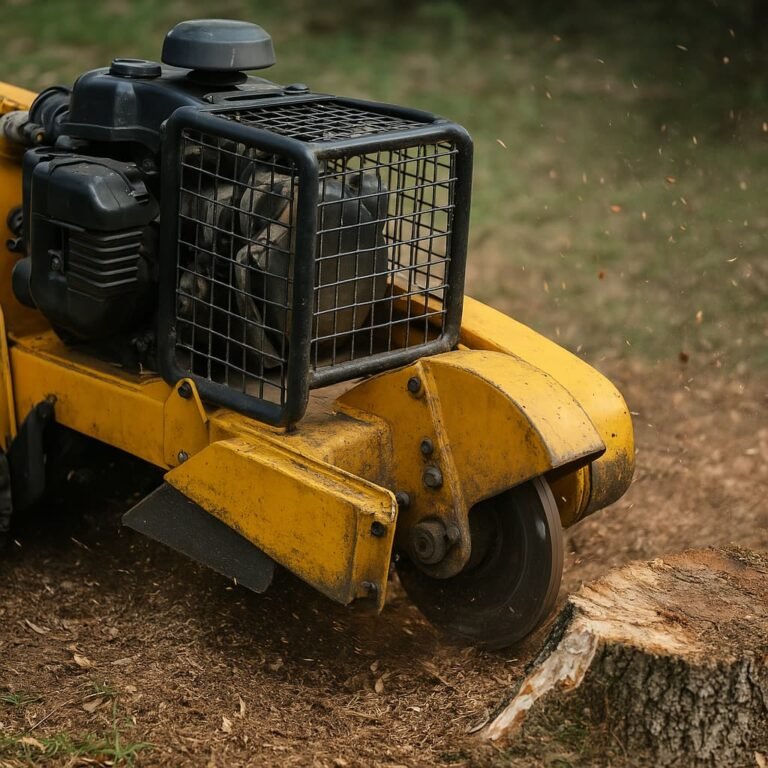Your Essential Guide to Stump Cutter Hire: Choosing & Using the Right Machine Safely
Tree stumps left in your garden look messy.
They can also be trip hazards or get in the way of new plans.
This guide helps you understand stump cutters, often called stump grinders.
We show you how to pick the right machine to hire from us.
Most importantly, we explain how to use it safely.
Stump Cutter Hire: Typical Daily Costs (UK)
Key Takeaways from the Chart
- The chart shows the typical daily hire cost range (£) for different types of stump grinders available in the UK.
- Handlebar Grinders (£80 – £150) are the most affordable but require the most physical effort. They are suitable for small stumps (under 12 inches) and tight access areas.
- Wheeled Self-Propelled Grinders (£150 – £300) offer a balance of power and maneuverability, ideal for medium-sized stumps (12-24 inches) in average gardens.
- Tracked Grinders (£300+) represent the highest cost but provide the most power and stability. They are necessary for large stumps (over 24 inches), multiple stumps, or challenging terrain like slopes. The chart shows the typical starting price; the upper range can vary significantly based on the specific model.
- Choosing the right machine involves balancing cost against the size/number of stumps, site access, and your physical ability. Remember to budget for potential extra costs like fuel and delivery.
What Exactly is a Stump Cutter (and a Stump Grinder)?
You might hear people say stump cutter or stump grinder.
Often, they mean the same thing: the whole machine that removes stumps.
Technically, the stump cutter is just the spinning wheel with sharp teeth.
This wheel does the actual wood cutting.
The stump grinder is the name for the entire machine, including the engine, wheels, and handles.
In this guide, when we say stump cutter, we usually mean the whole stump grinder machine you can hire.
We focus on helping you hire the right machine for your job.
Safety First: CRITICAL Precautions Before You Hire a Stump Cutter
Using a stump cutter needs great care.
Your safety is the most important thing.
Ignoring safety rules can lead to serious injury or damage.
Please read this section very carefully before you hire.
The Biggest Danger: Locating Underground Utilities (Gas, Electric, Water)
This is the number one safety rule.
Hitting underground pipes or cables is extremely dangerous.
It can cause gas leaks, electric shocks, floods, or explosions.
It could injure or kill you or others. Repairs are also costly.
You MUST check for underground utilities BEFORE you start grinding.
The free online service called “Line search before U dig” (LSBUD) is used in the UK.
They contact utility companies for you.
The companies will send you maps showing where their pipes and cables are.
Do not grind until you have received and checked these plans.
Mark any known private lines, like garden lighting cables or sprinkler pipes.
Real User Warning: “Check, double-check, and triple-check for underground lines. I can’t stress this enough. A mate hit a water pipe – massive mess and cost.” (Paraphrased from landscaping forum)
Essential Personal Protective Equipment (PPE): Your Non-Negotiable Gear
Stump cutters throw wood chips and sometimes stones at high speed.
The machine is loud and vibrates.
You must wear the proper safety gear.
- Eye Protection: Wear safety glasses or, even better, a full face shield. This stops flying bits from hitting your eyes or face.
- Hearing Protection: Use ear defenders or proper earplugs. Stump grinders are very noisy and can damage your hearing.
- Footwear: Wear strong, sturdy boots. Steel-toe caps give the best protection against falling objects or the machine itself.
- Gloves: Tough work gloves protect hands from splinters and vibration and improve grip on the machine.
- Leg Protection: Chainsaw trousers or chaps are highly recommended. They protect your legs if the cutter accidentally contacts them.
Why PPE Matters: Landscaping work involving machinery has high injury rates. Protecting yourself significantly reduces your risk.
Understanding Machine Hazards: Flying Debris, Kickback, and Stability
Be aware of how the machine works and its risks.
Flying Debris: The cutter wheel throws debris far and fast. Make sure the machine’s safety guards are in place. Never bypass them.
Kickback: The machine can jump or kick back if the cutter hits something complex (like a hidden rock) or is used too aggressively. Always hold the machine firmly with both hands.
Stability: Be careful on slopes or uneven ground. The machine could tip over. Tracked grinders offer better stability on slopes.
Preparing Your Work Area Safely
Clear the area around the stump properly.
Remove all rocks, stones, bricks, old metal, and loose bits of wood.
Hitting these things can damage the stump cutter teeth instantly.
It also makes flying debris dangerous.
Keep everyone else away.
Children, pets, and neighbours must stay far from the working area (at least 50 feet / 15 metres is often recommended). Rope off the area if needed.
How Does a Stump Cutter Work? The Grinding Process Explained
A stump cutter works like a powerful grinder for wood.
It has a heavy, spinning wheel called the cutter wheel.
This wheel has very hard, sharp teeth fixed onto it, usually made with carbide tips.
The engine powers the wheel to spin extremely fast.
You control the machine to move the spinning cutter wheel over the tree stump.
You gently lower the wheel onto the wood.
Then you sweep the wheel slowly from side to side across the stump surface.
The sharp teeth rapidly chip away at the wood.
They turn the solid stump into small wood chips, like coarse sawdust or mulch.
You repeat this sweeping motion, gradually grinding the stump lower and lower.
Most stump cutters aim to grind the stump down below the ground level.
Fact: Depending on the machine size, you can grind between 4 inches (10cm) and 18 inches (45cm) below the soil surface. Professional machines can go deeper if needed.
This allows you to put soil over the top and grow grass or other plants.
Compact / Handlebar Stump Grinders: For Small Stumps & Tight Access
These are the smallest type of stump grinder.
They have handles like a lawnmower.
You push, pull, and guide them manually.
They have less powerful engines.
Best for:
- Small tree stumps (e.g., from shrubs or small garden trees).
- Getting into tight spaces like narrow garden gates or back gardens with limited access.
Things to know:
- They require more physical effort from you to move and operate.
- They are slower on medium or larger stumps.
- User Insight: “Those small handlebar grinders vibrate like crazy. Be prepared for a workout!” (Common sentiment from DIY forums)
Self-Propelled Wheeled Stump Grinders: The Versatile Choice
These are a popular choice for many jobs.
They have powered wheels, making them easier to move around.
You still guide them, but the engine helps drive the wheels.
They have more powerful engines than handlebar models.
Best for:
- Medium-sized stumps (most common garden tree sizes).
- Average residential jobs where access is reasonable (standard gate width).
- Situations where you want less physical strain than a handlebar model.
Things to know:
- They are faster and more efficient than smaller grinders.
- They handle moderately uneven ground okay.
Tracked Stump Grinders: Powering Through Large Stumps & Tough Terrain
These are the most powerful stump grinders we offer for hire.
They run on rubber tracks, like a mini-tank.
This gives them excellent stability and grip.
They usually have powerful engines and hydraulic controls for smooth operation.
Best for:
- Large tree stumps (old, mature trees).
- Removing multiple stumps efficiently.
- Working on slopes or very uneven, muddy ground.
- Professional or heavy-duty use.
Things to know:
- They are the most efficient and fastest option for big jobs.
- Their tracks spread the weight, often causing less ground damage than wheels on soft ground.
- They are larger machines, so they need wider access.
Understanding Cutter Teeth: Sharpness Matters
All our hire machines have their cutter teeth checked and maintained.
Sharp teeth cut wood much faster and more smoothly.
Dull teeth slow the job and put more strain on the machine (and you!).
Tip: “Hitting rocks dulls the teeth instantly. Clear the area well before you start.” (Advice often shared by experienced users)
Choosing the Right Stump Cutter for Your Job: Key Factors
Picking the best machine depends on your specific situation.
Think about these points before you hire:
Assess Your Stump(s): Size, Wood Type, and Quantity Matter.
Size: Measure the stump diameter across its widest point at ground level.
* Small stumps (under 12 inches / 30cm): A handlebar grinder might be okay.
* Medium stumps (12-24 inches / 30-60cm): A self-propelled wheeled grinder is often best.
* Large stumps (over 24 inches / 60cm): A tracked grinder is usually needed for efficiency.
Wood Type: Hardwoods (like oak and beech) are tougher to grind than softwoods (like pine and fir). Allow more time or choose a more powerful machine for hardwoods.
Quantity: Hiring a larger, faster machine (wheeled or tracked) can save you time and effort if you have many stumps. Even if some stumps are small.
Evaluate Site Access and Terrain
Can you get the machine to the stump?
Measure: Check the width of gates, paths, or narrow points the machine must pass through. We list the width of our machines on their hire pages.
Obstacles: Are there steps, steep slopes, very soft ground, or obstacles to go around?
* Tight access often means a handlebar grinder is the only option.
* Slopes or rough ground favour a tracked grinder for stability.
Consider Your Physical Ability and Experience
Be honest about how much physical work you can comfortably do.
Handlebar grinders require the most effort to push, pull, and control.
Even wheeled grinders involve guiding a heavy machine.
If you are not used to operating machinery, start slowly and carefully.
Always read the operating instructions provided with the hired machine.
The Stump Grinding Process: A Step-by-Step Overview for Hirers
Knowing the basic steps helps you plan your job.
Pre-Grinding Checklist (Safety, Fuel, Machine Familiarisation)
- Safety First: Did you do the utility check (LSBUD)? Is the area clear of rocks and debris? Are pets and people far away? Put on all your PPE.
- Fuel & Oil: Check fuel and oil levels as the instructions show. Use the correct fuel type.
- Machine Familiarisation: Before starting the engine, understand the controls. Know how to start, stop, raise/lower the cutter wheel and move the machine. We provide instructions when you hire. Ask questions if unsure!
Operating the Stump Cutter Effectively (Starting, Sweeping, Depth)
- Start Safely: Start the engine in an open area, away from the stump, following the instructions.
- Position: Move the machine carefully towards the stump. Position the cutter wheel just above the edge of the stump you want to start on.
- Grind: With the engine at operating speed, gently lower the spinning wheel a small amount (e.g., 1-2 inches) into the wood.
- Sweep: Slowly swing the cutter head from side to side across the wood, like painting with a brush. Let the teeth do the work – don’t force it.
- Lower & Repeat: After sweeping across the top layer, lower the wheel slightly deeper and sweep across again.
- Continue: Repeat this process, working your way down through the stump until you reach the desired depth below ground level.
- Chase Roots: You can also grind out visible surface roots connected to the stump similarly.
Pro Tip: “Don’t try to take off too much wood in one pass. Small, steady sweeps work best and are easier on the machine.”
Managing Wood Chips and Site Cleanup
Stump grinding creates a lot of debris.
It’s a mix of wood chips and soil.
The volume can be surprisingly large, often several wheelbarrows full from one medium stump.
What to do with the chips:
- Mulch: The mix can be used as mulch around other plants or trees (though fresh chips can sometimes affect soil nitrogen). If you are concerned, let it compost for a while first.
- Compost: Add it to your compost heap (mix well with green waste).
- Disposal: Check your local council’s rules for green waste disposal. You might need to bag it or take it to a recycling centre.
Cleanup: After grinding, you will need to rake up the chips. If you plan to plant grass, fill the hole left by the stump with the chip/soil mix or fresh topsoil.
Be Aware: “Don’t underestimate cleanup – the chips go everywhere! It took me almost as long to rake up as it did to grind.” (Common DIY experience)
Common Problems & Quick Solutions Summary Box
| Problem | Possible Cause | Quick Solution |
|---|---|---|
| Machine Won’t Start | Fuel empty/off, Spark plug issue | Check fuel level & tap. Check spark plug connection. |
| Cutter Wheel Stops Spinning | Trying to cut too fast, Belt issue | Lift wheel out of cut, reduce sweep speed. Check belt tension (if safe/instructed). |
| Excessive Vibration | Damaged/missing teeth, Uneven ground | Stop! Inspect teeth. Move to more level ground if possible. |
| Hitting Rocks/Debris | Area not cleared well enough | Stop immediately! Clear area better. Inspect teeth for damage. |
| Machine Bogging Down | Cutting too deep/fast, Blunt teeth | Reduce depth of cut per pass. Slow down sweep speed. |
Refer to the machine’s manual or contact us if you have problems.
DIY Stump Cutter Hire vs. Hiring Our Professional Service
Should you hire a machine and do it yourself, or pay for a service?
Here’s a comparison to help you decide.
Benefits and Drawbacks of Hiring and Operating Yourself
Benefits:
- Cost Saving: Usually cheaper than paying for labour if you only count the hire fee.
- Job Satisfaction: A Good feeling doing the job yourself.
- Flexibility: Work at your own pace, when it suits you (within the hire period).
Drawbacks:
- Physical Effort: It’s hard work, especially with smaller machines or large stumps. Expect vibration and need the strength to guide it.
- Learning Curve: Takes time to get used to operating the machine safely and efficiently.
- Transport: A suitable vehicle (van, trailer) and ramps are needed to collect and return larger machines or pay for delivery.
- Safety Responsibility: You are responsible for safety, especially checking for utilities. Mistakes can be very costly or dangerous.
- Time: Collecting the machine, prepping the site, grinding, cleaning up, and returning the machine takes time.
- Potential Hidden Costs: Fuel, possible damage waiver/insurance, and cleaning fees.
- Result: Might not get the stump as deep or the finish as neat as a professional.
DIY Case Study Example: A homeowner hired a small handlebar grinder for one large, old oak stump (30 inches).
After 4 hours of tough, vibrating work on a Saturday, they had only managed to grind down about 6 inches. The effort was massive, and the result wasn’t deep enough to turf over.
They realised a professional with a larger machine was needed.
When is Our Professional Service the Better Option?
Consider using a professional stump grinding service (like ours, if offered) when:
- You have very large or hardwood stumps.
- You have many stumps to remove.
- Access is complicated or requires specialist equipment.
- You have limited time or physical ability.
- You want peace of mind knowing that safety checks (especially utilities) are handled professionally and the work is insured.
- You want maximum convenience – the job done quickly and efficiently with minimal fuss.
- You need the stump ground intensely for replanting.
Professional Service Benefit: Experienced operators with powerful machines can often remove multiple stumps faster and cleanly than a DIY hire. They also handle debris disposal.
Understanding Stump Cutter Hire Costs in the UK
Knowing the likely costs helps you budget.
Prices vary based on machine size, hire duration, and location.
Typical Hire Rates: What to Expect
These are general estimates per day (check our website for exact prices):
- Small Handlebar Grinders: £80 – £150 per day.
- Medium Self-Propelled Wheeled Grinders: £150 – £300 per day.
- Large Tracked Grinders: £300+ per day.
Weekend or weekly hire rates often offer better value per day.
Hire Cost Summary Table (Estimates)
| Machine Type | Typical Day Rate (£) | Best For | Notes |
|---|---|---|---|
| Handlebar Grinder | 80 – 150 | Small stumps, tight access | Most physical effort |
| Wheeled Self-Propelled | 150 – 300 | Medium stumps, average gardens | Good all-rounder, easier than handlebar |
| Tracked Grinder | 300+ | Large/multiple stumps, slopes, tough ground | Most powerful & stable, needs wider access |
Prices are estimates only. Delivery/collection may be extra.
Factors Affecting the Final Hire Price
- Machine Size: Bigger machines cost more per day.
- Hire Duration: Longer hires (weekend, week) usually have a lower daily rate.
- Delivery/Collection: Fees often apply if you don’t collect/return it yourself.
Don’t Forget Potential Extra Costs
Budget for these too:
- Fuel: You must supply the Fuel (petrol or diesel, depending on the machine). Grinders can be thirsty.
- Damage Waiver/Insurance: Sometimes offered or required, adds a percentage to the hire cost but covers accidental damage.
- Cleaning Fees: Machines should be returned reasonably clean. A charge may apply if the item is returned covered in mud/debris.
Tips from Experience: Making Your Stump Cutter Hire Successful
Learn from others who have hired stump cutters:
- “Clear twice as much debris around the stump as you think you need to.” Hidden rocks are a common problem.
- “Ensure you understand all the controls BEFORE you start the engine.” Don’t be afraid to ask for a full demonstration when you collect.
- “Take your time, especially if it’s your first go.” Rushing leads to mistakes or poor results. Let the machine do the work.
- “If you have more than 2 or 3 medium stumps, seriously consider getting a pro service or hiring a bigger machine.” It saves so much time and backache.
- “Wear your PPE properly the whole time the machine is running.” No shortcuts on safety.
- “Factor in the cleanup time. It always takes longer than you expect!”
Frequently Asked Questions (FAQS) about Stump Cutter Hire
Here are answers to some common questions:
How deep should I grind the stump?
It depends on what you want to do with the area afterwards.
- Grinding 4-6 inches (10-15cm) below ground level is usually enough for growing grass.
- For planting shrubs or small plants: Aim for 8-12 inches (20-30cm) deep.
- For planting another tree: You may need to go deeper, 12-18 inches (30-45cm), or remove the ground-out chips and replace them with topsoil.
Can a hired stump cutter remove tree roots too?
It easily grinds the central stump mass below ground. It can also grind large roots visible on the surface near the stump. However, it’s not designed to chase extensive root systems far into the lawn. Its focus is on the central stump area.
What do I do with the wood chips after grinding?
You have a few options:
- Use them as natural mulch in flower beds (best to let them compost a bit first).
- Add them to your compost bin (mix well with green stuff).
- Bag them up for your local council green waste collection (check their rules).
- Use some to fill the hole where the stump was, then top with soil for grass.
Do I need special training to hire a stump cutter?
No formal certificate is usually needed for hiring. However, you must be competent and confident to operate it safely. We provide operating and safety instructions. You must read these and follow them carefully. If you feel unsure after reading the instructions, please let us know before taking the machine. Your safety is vital.
Disclaimer: This guide provides general information and safety advice. Always refer to the specific operating manual supplied with the hired machine and follow all safety procedures. Treestumpgrinderhire.com is not liable for accidents or damage resulting from improper use or failure to follow safety guidelines.

